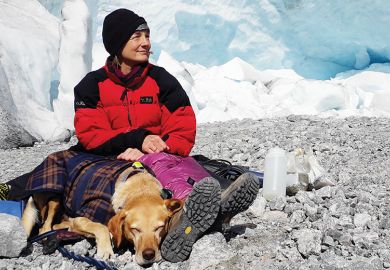The 1990s International Decade for Natural Disaster Reduction has raised questions about how environmental hazards and their consequences should be analysed. The traditional view was that "natural disasters" are extreme, short-term geophysical events originating in the environment and external to society. More recently, given the pressing need to stem the growing global toll of death and destruction, most commentators would now agree that all disasters reflect a complex interaction between environmental, technological and social processes. Currently, the paradigm pendulum has swung - perhaps too far - to the point where the geophysical event is often seen as a means of exposing endemic human vulnerability and disasters are increasingly treated as social phenomena.
Ernest Zebrowski, professor of physics at Pennsylvania State University, sidesteps this debate and places himself firmly in the traditionalists' camp. His work is addressed rather oddly not to "disaster specialists, butI professionals, policy makers, students and independent thinkers, present and future". While there are many advantages in bringing a fresh pair of eyes to an old problem, there is always the danger that some disciplinary blinkers will be attached to a particular "perspective". In this case, the author provides an interesting account of the ways in which changing views of science and technology have influenced our understanding of the relevant environmental science, ranging from astronomy and the ancient Greeks to the butterfly effect and chaos theory, but he is almost completely oblivious to the contemporary shifts in thinking affecting the application of that science to modern disasters.
The book falls into several parts. The first three chapters, which are probably the most useful, illustrate very well how core scientific principles have been applied, and even mis-applied, historically. For example, the treatment of building materials subjected to stress and leading to the collapse of hazard-resistant structures is a fine introduction to this subject.
Zebrowski then has separate, and more routine, chapters on a selected range of hazards which deal mainly with epidemics, tsunamis, earthquakes, volcanoes and hurricanes. Each theme is illuminated with relevant case studies of individual disasters worldwide. The final chapter explores the limits of science.
Essentially, the content is relatively strong on tectonic hazards but it is a little unbalanced in that there is virtually nothing on river and coastal floods, which are the most frequently occurring types of natural disaster. The book concludes by emphasising the important point that extreme geophysical events have proved highly resistant to conventional scientific enquiry, such as statistical determinism, and that successful prediction is still to be achieved for many disasters.
The arguments are aided by clear diagrams, together with black-and-white photographs. There are 14 pages of appendices and an index. The book is written in a relaxed and entertaining style supported by notes rather than extensive references.
In some ways, this is a discouraging book because the author seems to undermine his own faith - and that of the reader - in the practical role of classic science and technology in disasters, particularly in relation to the mitigation of future hazards.
He concludes that "as scientists, we are today being driven to the conclusion that we simply don't have a fruitful way of studying complex irreproducible phenomena". The reader is then invited to look forward to a world dependent on more of the same technological responses, such as bigger and better sea walls and new satellites. Admittedly, some speculative hope is offered through the emergence of a so-called "new science", which will somehow overcome the fragmentation of modern science and stimulate fresh lines of enquiry. This aspiration is never detailed in a convincing manner. Its success seems to depend, somewhat unrealistically in the financial climate, on the injection of greater public resources into the sort of blue-skies research that may eventually lead to a brave new world ofI "futuristic benefitsI weather control, earthquake control and perhaps even epidemic control".
The field of disaster research is theoretically and empirically diverse. Science and technology, as described by Zebrowski, will undoubtedly continue to make vital contributions towards a safer world in the 21st century and there are important questions to be asked about how such efforts can be most effectively deployed. Unfortunately, the results will have to be understood and implemented by policy-makers and ultimately by the people at risk, if the scientific advances are to attain their full potential. In other words, the crucial need is not always more science but a better grass-roots use of the science we already have. Thus, more lives will not be saved in disasters caused by volcanoes or hurricanes unless scientific forecasts are translated into better community warnings for volcanic slopes and coastal plains that will enable more effective evacuation procedures and other damage-reducing measures.
Zebrowski is right to highlight the limitations to progress and human welfare that arise when scientists fail to speak to each other. But scientists concerned with real-world problems also have some responsibility to communicate with other workers and with the end-users of their products. In the disaster arena, science and technology alone are not enough simply because there is no such thing as an entirely "natural disaster". Already, many hazard-reducing strategies based on forecasting or engineering techniques are justly criticised for being economically and environmentally unsustainable, especially in the less developed parts of the world that suffer the greatest disaster impact.
These ongoing tragedies suggest that it is the human, rather than geophysical causes of disaster that are least well understood. Instead of relying on the "top-down" transfer of new technological fixes in the future, a precautionary blend of the natural and the social sciences that enables each country and each community to develop its own capacity for mitigating hazards is a more likely way forward.
Keith Smith is professor of environmental science, University of Stirling.
Perils of a Restless Planet: Scientific Perspectives on Natural Disasters
Author - Ernest Zebrowski, Jr.
ISBN - 0 521 57374 2
Publisher - Cambridge University Press
Price - £16.95
Pages - 306
Register to continue
Why register?
- Registration is free and only takes a moment
- Once registered, you can read 3 articles a month
- Sign up for our newsletter
Subscribe
Or subscribe for unlimited access to:
- Unlimited access to news, views, insights & reviews
- Digital editions
- Digital access to THE’s university and college rankings analysis
Already registered or a current subscriber?



